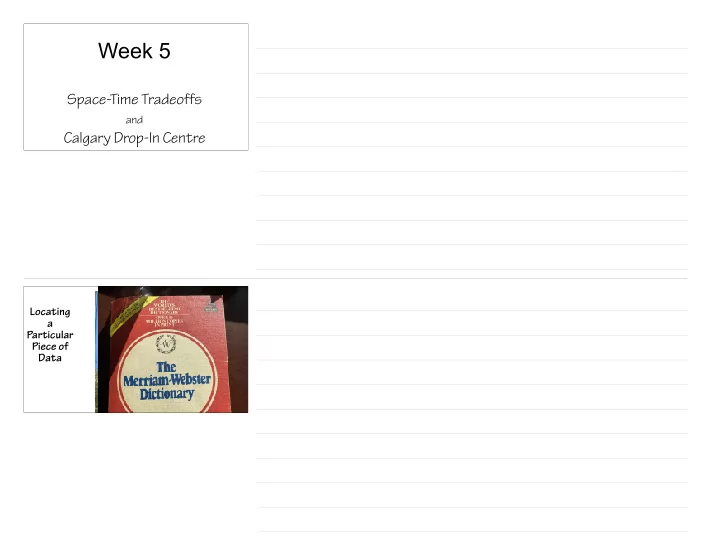

Week 5 Space-Time Tradeoffs and Calgary Drop-In Centre Locating a Particular Piece of Data 2
Growth-rate Functions O(1) – constant time, the time is independent of n , e.g. array look-up O(log n ) – logarithmic time, usually the log is base 2, e.g., binary search O( n ) – linear time, e.g. linear search O( n *log n ) – e.g. efficient sorting algorithms O( n 2 ) – quadratic time, e.g. selection sort O(n k ) – polynomial (where k is some constant) O(2 n ) – exponential time, very slow! Comparison of Growth-rate Functions n 10 100 1,000 10,000 100,000 1,000,000 1 1 1 1 1 1 1 log 2 n 3 6 9 13 16 19 n 10 10 2 10 3 10 4 10 5 10 6 n*log 2 n 10 5 10 6 10 7 30 664 9,965 n 2 10 2 10 4 10 6 10 8 10 10 10 12 n 3 10 3 10 6 10 9 10 12 10 15 10 18 10 3,010 10 30,103 2 n 10 3 10 30 10 301 10 301,030
Order-of-Magnitude Analysis and Big O Notation Intractable Algorithm "In the great temple of Benares … rests a brass 18,446,744,073,709,551,615 plate in which are fixed 3 diamond needles, each a cubit high and as thick as the body of a bee. On one of these needles, at the creation, God placed 64 disks of pure gold, the largest disk resting on the brass plate, and the others getting smaller and smaller up to the top one. This is the Tower of Brahmah … When the 64 disks shall have been transferred from the needle on which at the creation God placed them, to one of the other needles, tower, temple, and Brahmins alike will crumble into dust, and with a thunderclap the world will vanish!”
Part of ASCII / Unicode Table Hashing Explained https://www.youtube.com/watch?v=KyUTuwz_b7Q
Calgary Drop-In Centre’s Donor Information System Abstract In the spring of 2016, the director of finance and administration for the Calgary Drop-In & Rehab Centre was frustrated with the organization's legacy donor and volunteer information system. The technology platform was outdated, data integrity was out of control, costs were spiraling, and most importantly, required information was not available on demand. The director was concerned that these issues with the organization's information systems would interfere with its ability to maintain positive relationships with existing donors and to secure new financial supporters-ultimately, that it could have an impact on the agency's efforts to achieve more good in the community. He was contemplating three options to solve this problem: build a new in-house system to replace the current Microsoft Access database system; purchase customer relationship management software specifically developed for non-profit fundraising and relationship management and install this on personal computers and servers in the offices; or adopt a cloud-based fundraising solution, where the organization's data would be stored on a secure, shared platform administered by the vendor. More on the technical aspects of database index technology: https://docs.oracle.com/cd/E11882_01/server.112/e40540/ indexiot.htm#CNCPT721 The EU General Data Protection Regulation (GDPR) is the most important change in data privacy regulation in 20 years. See https://gdpr.eu
GDPR Requirements 1. Right to Access - Data subjects have the right to request a copy of their personal data. 2. Right to be Informed - Data subjects have the right to be informed of how personal data pertaining to them is being processed, and for what purpose. They have the right to know how long the personal data will be stored and who it will be shared with. (Article 13 + 14) 3. Right to Rectification - Data subjects have the right to fix inaccurate or incomplete personal data. (Article 16) 4. Right to be Forgotten - Data subjects have the right to request their personal data be erased from the data controller, and stop further dissemination of the data. (Article 17) 5. Right to Restrict Processing - Data subjects have the right to request restriction or suppression of their personal data. This is analogous to the Right to be Forgotten, but the data remains stored, rather than erased, and only applies in special cases, such as the data is inaccurate and is in the process of being rectified. (Article 18) 6. Right to Data Portability - Data subjects have the right to request a copy of their personal data in a machine-readable format. (Article 20) 7. Right to Object - Data subjects have the right to object to the processing of their data in certain circumstances, with the specific mention of direct marketing. (Article 21) 8. Rights related to Automated Decision Making - Data subjects have the right to request
Recommend
More recommend